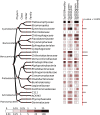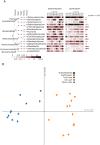Diversity and shifts of the bacterial community associated with Baikal sponge mass mortalities
- PMID: 30921366
- PMCID: PMC6438488
- DOI: 10.1371/journal.pone.0213926
Diversity and shifts of the bacterial community associated with Baikal sponge mass mortalities
Abstract
The disease of freshwater sponges was first discovered in 2011, when pink samples were found in the Central Basin of Lake Baikal. Subsequently, the visible signs of the disease have changed, and now sponges appear with various symptoms of damage to the body, such as discoloration, tissue necrosis, the formation of brown patches and dirty-purple biofilms on some branches. These signs of the disease are accompanied by the mass death of sponges. We identified differences in microbiomes by sequencing 16S rRNA genes and found changes in the consortium of microorganisms of freshwater Baikal sponges. We found that the observed imbalance in the studied microbial communities of diseased sponges is caused by several different conditionally pathogenic microorganisms that increase their negative effect by acting together and in concert, which leads to the death of photosynthetic microalgae and sponges. Sponges are an important component of coastal communities, and the massive loss of sponges can obviously affect the structure of benthic communities and the purity of water.
Conflict of interest statement
The authors have declared that no competing interests exist.
Figures





Similar articles
-
Brown Rot Syndrome and Changes in the Bacterial Сommunity of the Baikal Sponge Lubomirskia baicalensis.Microb Ecol. 2018 May;75(4):1024-1034. doi: 10.1007/s00248-017-1097-5. Epub 2017 Nov 2. Microb Ecol. 2018. PMID: 29098357
-
Effects of Seasonal Anoxia on the Microbial Community Structure in Demosponges in a Marine Lake in Lough Hyne, Ireland.mSphere. 2021 Feb 3;6(1):e00991-20. doi: 10.1128/mSphere.00991-20. mSphere. 2021. PMID: 33536324 Free PMC article.
-
Exploring the diversity-stability paradigm using sponge microbial communities.Sci Rep. 2018 May 30;8(1):8425. doi: 10.1038/s41598-018-26641-9. Sci Rep. 2018. PMID: 29849034 Free PMC article.
-
Marine sponge microbial association: Towards disclosing unique symbiotic interactions.Mar Environ Res. 2018 Sep;140:169-179. doi: 10.1016/j.marenvres.2018.04.017. Epub 2018 Apr 27. Mar Environ Res. 2018. PMID: 29935729 Review.
-
Microorganisms of Lake Baikal-the deepest and most ancient lake on Earth.Appl Microbiol Biotechnol. 2020 Jul;104(14):6079-6090. doi: 10.1007/s00253-020-10660-6. Epub 2020 May 18. Appl Microbiol Biotechnol. 2020. PMID: 32424436 Review.
Cited by
-
Microbiome of the freshwater sponge Ephydatia muelleri shares compositional and functional similarities with those of marine sponges.ISME J. 2022 Nov;16(11):2503-2512. doi: 10.1038/s41396-022-01296-7. Epub 2022 Jul 29. ISME J. 2022. PMID: 35906397 Free PMC article.
-
Relationship between bacterial phylotype and specialized metabolite production in the culturable microbiome of two freshwater sponges.ISME Commun. 2022 Mar 10;2(1):22. doi: 10.1038/s43705-022-00105-8. ISME Commun. 2022. PMID: 37938725 Free PMC article.
-
Cooperative Interaction of Janthinobacterium sp. SLB01 and Flavobacterium sp. SLB02 in the Diseased Sponge Lubomirskia baicalensis.Int J Mol Sci. 2020 Oct 30;21(21):8128. doi: 10.3390/ijms21218128. Int J Mol Sci. 2020. PMID: 33143227 Free PMC article.
-
Isolation and Properties of the Bacterial Strain Janthinobacterium sp. SLB01.Microorganisms. 2022 May 23;10(5):1071. doi: 10.3390/microorganisms10051071. Microorganisms. 2022. PMID: 35630513 Free PMC article.
-
Diversities and Shifts of Microbial Communities Associated with Farmed Oysters (Crassostrea gigas) and Their Surrounding Environments in Laoshan Bay Marine Ranching, China.Microorganisms. 2023 Apr 29;11(5):1167. doi: 10.3390/microorganisms11051167. Microorganisms. 2023. PMID: 37317141 Free PMC article.
References
-
- Manconi R., Pronzato R. Suborder Spongillina subord. nov.: Freshwater Sponges In: Hooper JNA, Van Soest RWM, Willenz P, editors. Systema Porifera. Springer, Boston, MA: 2002. pp. 921–1019. 10.1007/978-1-4615-0747-5_97 - DOI
-
- Manconi R, Pronzato R. Global diversity of sponges (Porifera: Spongillina) in freshwater. Hydrobiologia. 2008;595: 27–33. 10.1007/978-1-4020-8259-7_3 - DOI
Publication types
MeSH terms
Substances
LinkOut - more resources
Full Text Sources

